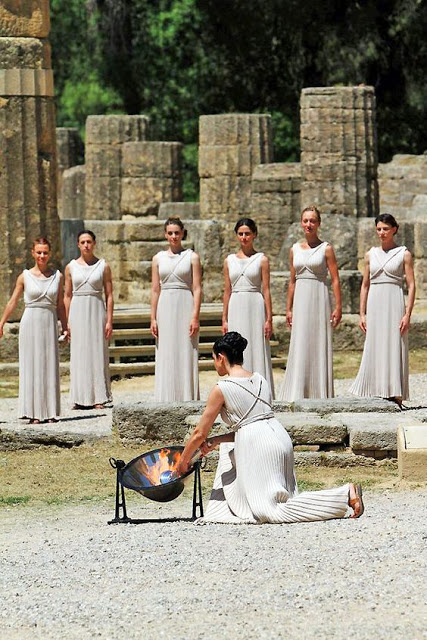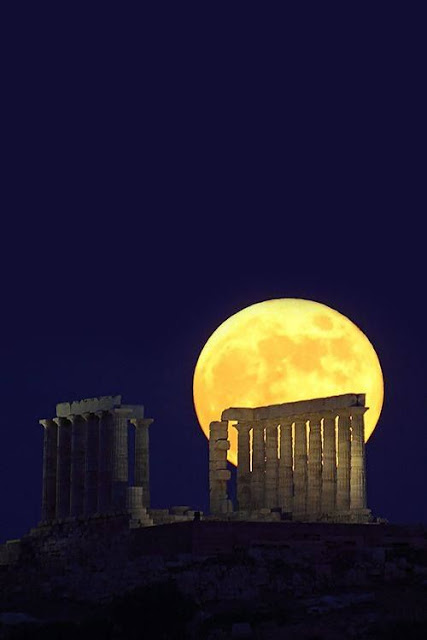Greece and the Mysterious Full Moon of August

Full moon over The Acropolis. Athens, Greece
Greece is positively enchanting but when beheld under the full moon of August, it is transformed into something truly magical.
Why the August full moon?
This full moon, known as the sturgeon moon, owing to the large number of fish found around this time, in the lakes of North America, is the brightest, most beautiful moon of the year.
Viewed in the Northern hemisphere, the full moon of August, is low on the horizon, which gives the illusion that it is so close to earth, you could reach out and touch it!
The dazzling light causes the moon to seem almost as radiant as the sun, turning night into a never-ending twilight.

Full mooon at The Temple of Apollo. Ancient Corinth, Greece
Ancient Greece and August full moon celebrations
In ancient times, the month of August, named Metageition, in the ancient Athenian or Attic calendar, was a month of festivals and celebrations
The word “Metageition” (meta – among and geition – neighbour), meant it was a time for partying, mixing with the neighbours!

Ancient Greek Athenian or Attic Calendar
The ancient Olympic Games, held in honour of Zeus and staged in Ancient Olympia from 776 BC-393 began on the day (The day, in ancient Greece, began at sunset, not at midnight, as today) of the August full moon, and were held every four years.

Ancient Olympia, Greece. Home of the Olympic Games
The tradition still holds today, the modern Olympic Games are held in August, it is a matter of luck though, if the opening ceremony falls on the day of the full moon.

The Krypte, official entrance to the stadium of ancient Olympia.
Photo Mark Cartwright
Selene: Titan Goddess of the moon
Ancient Greece has invariably been connected with the mystical moon, from the ancient lunar calendar, to incredible stories from Greek mythology.
The most well-know Greek “Moon Myth” is Selene (Also one of the Greek words for moon), Titan Goddess of the moon, who traversed the night sky, in her silver chariot, the moon, drawn by two, snow-white, winged horses.

Selene, Goddess of the Moon by Albert Aublet. 1880
The love of Selene’s life was Endymion, the shepherd Prince, the most handsome boy Selene had ever set eyes on and who was granted eternal youth and immortality and put into a never-ending state of sleep by Zeus.
Selene paid nightly visits to Endymion, in his cave on Mount Latmos and eventually bore him fifty daughters, who represented the fifty lunar months of the Olympiad, or period of four years, marking the beginning of the Olympic Games.

Selene visiting Endymion – Ubaldo Gandolfi
Present day August full moon festivals in Greece

Acropolis under the light of the full moon of August
Today, on the day of the August full moon, archaeological sites throughout Greece, stay open well after midnight, entrance is free.
To see the brilliant white marble of the Acropolis, glowing in the moonlight, or the moon, hanging low over the Temple of Poseidon at Sounion, is a sight never to be forgotten!

Full moon over the Temple of Poseidon – Cape Sounion
Greece
Many festivities, including singing, dancing, musical performances and poetry reading, food abundant and wine flowing, are held under the light of the moon at about a hundred archaeological sites and museums all over Greece.

Full moon over The White Tower. Thessaloniki, Greece
Years ago, the Acropolis remained open all night, not only for the full moon of August but for all twelve full moons of the year.
Athenians would prepare picnics, to be eaten in the glow of the magnificent marble columns of the Parthenon and spend the night there, dreaming of magical nights in faraway ancient Greece.
Do try to visit Greece in August, around the time of the full moon and see for yourself one of her many other faces!

August full moon. Greece
“Everyone is a moon, and has a dark side which he never shows to anybody.”
Mark Twain



